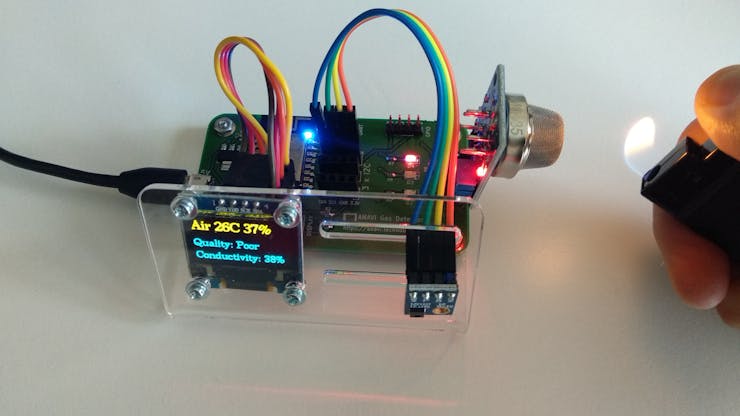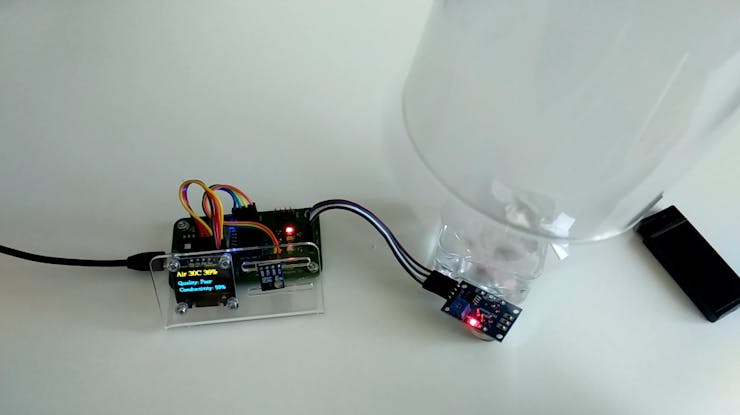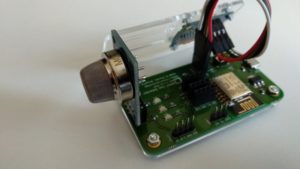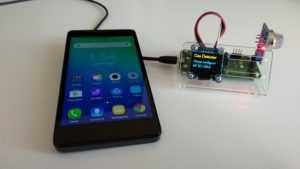There is a huge variety on the market of analog MQ gas sensor modules for Arduino compatible devices. In this article we will focus on MQ-135. This low-cost analog sensor is used in air quality control equipment for buildings and offices. It is suitable for detecting of NH3, NOx, alcohol, Benzene, smoke, CO2 and other dangerous gases.

MQ-135 has a built-in heater that provides the required work environment for the sensor. The heater operates at 5 V. There is a sensitive layer which has lower conductivity in clean air. The sensor’s conductivity gets higher as the gas concentration rises. Depending on the conductivity, the sensor outputs analog data in a range of 0 to 5 V. ANAVI Gas Detector is powered by ESP8266 which has a built-in analog to digital converter (ADC) with range of 0 to 1 V. Resistors have been added to the printed circuit board to act as a voltage divider and to fix the range difference. This way ANAVI Gas Detector reads correct data from the analog output of MQ-135.
The gas sensitivity of MQ-135 depends on the temperature and humidity influence. Therefore the advanced and developer kits of ANAVI Gas Detector include HTU21D I2C sensor module for temperature and humidity.
As explained in the video and shown in the datasheet of the sensor, MQ-135 requires calibration. At first launch the so called “burn-in” (or preheat) procedure must be performed by leaving the sensor working for 48 hours in a room with a clean air.

ANAVI Gas Detector is used in all demonstrations in the video. It is an ESP8266-powered, open source, Wi-Fi dev board for monitoring air quality and detecting dangerous gases with MQ-135. ANAVI Gas Detector is a certified open source hardware (UID BG000018). I have designed it with the free and open source software KiCad. The acrylic enclosure has been designed with another open source tool OpenSCAD. The schematics and the Arduino sketch are available at GitHub. It is easy to use ANAVI Gas Detector: attach MQ-135, mini OLED display and HTU21D temperature and humidity sensor to ANAVI Gas Detector, connect the board to your WiFi and after the “burn-in” procedure you can monitor the air quality.
Detecting Flammable Gases

MQ-135 detects flammable gases. The 1st demonstration in the YouTube video show how the conductivity increases when a lighter has been turned on near MQ-135. It is important to note that the sensor detects the flammable gas coming out of the lighter which is invisible, not directly the flame.
Detecting Smoke

MQ-135 detects smoke. The 2nd demonstration in the YouTube video show how the conductivity increases and the air is reported as poor when the MQ-135 gas sensor module is near smoke for a burning paper.
Detecting Alcohol

MQ-135 detects alcohol. As you can see in the 3rd demonstration in the YouTube video the conductivity increases when the sensor is near alcoholic drinks.
Note: if want to make more precise do-it-yourself breath analyzer please consider using MQ-3 with ANAVI Gas Detector.
A very successful crowdfunding campaign is running in Crowd Supply to fund mass productions of ANAVI Gas Detector. All kits include MQ-135. The crowdfunding campaign has already met its goal. Order now to be among the first owners of ANAVI Gas Detector!






